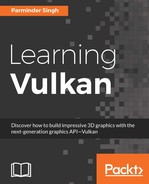- Learning Vulkan
- Learning Vulkan
- Credits
- About the Author
- Acknowledgments
- About the Reviewer
- www.PacktPub.com
- Preface
- 1. Getting Started with the NextGen 3D Graphics API
- 2. Your First Vulkan Pseudo Program
- Installing Vulkan
- The Hello World!!! pseudocode
- Initialization - a handshake with the device
- Swapchain initialization - querying the WSI extension
- Supplying shaders - shader compilation into SPIR-V
- Building layouts - descriptor and pipeline layouts
- Creating a Render Pass - defining a pass attribute
- Framebuffer - connect drawing images to the Render Pass
- Populating geometry - storing a vertex into GPU memory
- Pipeline state management - creating pipelines
- Executing the Render Pass - drawing Hello World!!!
- Queue submission and synchronization - sending jobs
- Displaying with presentation layer - rendering a triangle
- Fitting it all together
- Summary
- 3. Shaking Hands with the Device
- 4. Debugging in Vulkan
- 5. Command Buffer and Memory Management in Vulkan
- 6. Allocating Image Resources and Building a Swapchain with WSI
- Getting started with image resources
- Understanding image resources
- Memory allocation and binding image resources
- Introducing swapchains
- Understanding the swapchain implementation flow
- The swapchain implementation's class block diagram
- Renderer - a window management custom class
- VulkanSwapChain - the swapchain manager
- Creating the surface with WSI and associating it with the created window
- The graphics queue with present support
- Querying swapchain image formats
- Creating the swapchain
- Creating a depth image
- Summarizing the application flow
- Summary
- 7. Buffer Resource, Render Pass, Framebuffer, and Shaders with SPIR-V
- 8. Pipelines and Pipeline State Management
- Getting started with pipelines
- Caching pipeline objects with a PCO
- Creating a graphics pipeline
- Understanding compute pipelines
- Pipeline State Objects (PSO) in Vulkan
- Implementing the pipeline
- Summary
- 9. Drawing Objects
- Overview of the drawing process in Vulkan
- Preparing the drawing object
- Rendering the drawing object
- Rendering an indexed geometry
- Understanding synchronization primitives in Vulkan
- Resizing the display window
- Summary
- 10. Descriptors and Push Constant
- 11. Drawing Textures
- Image resource - a quick recap
- Prerequisites for texture drawing
- Implementing the image resource with linear tiling
- Implementing the image resource with optimal tiling
- Loading the image file
- Buffer object memory allocation and binding
- Populating the allocated device memory
- Creating the image object
- Image object memory allocation and binding
- Creating a command buffer object
- Setting the image layout
- Buffer to image copy
- Setting the optimal image layout
- Submitting the command buffer
- Creating an image sampler
- Creating the image view
- Copying data content between images and buffers
- Updating the descriptor set
- Summary
This chapter was short, precise, and full of practical implementations. Working on Vulkan without debugging capabilities is like shooting in the dark. We know very well that Vulkan demands an appreciable amount of programming and developers make mistakes for obvious reasons; they are humans after all. We learn from our mistakes, and debugging allows us to find and correct these errors. It also provides insightful information to build quality products.
Let's do a quick recap. We learned the Vulkan debugging process. We looked at the various LunarG validation layers and understood the roles and responsibilities offered by each one of them. Next, we added a few selected validation layers that we were interested in debugginig. We also added the debug extension that exposes the debugging capabilities; without this, the API's definition could not be dynamically linked to the application. Then, we implemented the Vulkan create user define debug report function and linked it to our debug reporting callback; this callback decorates the captured debug report in a user-friendly and presentable fashion. Finally, we implemented the API to destroy the debugging report callback object.
In the next chapter, we will understand command buffers, explore their role in the Vulkan pipeline, and learn to use them to record and execute API calls. We will also take an in-depth look at the Vulkan memory management for host and device memory; we will learn about various APIs to control them.
-
No Comment
